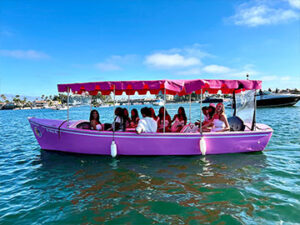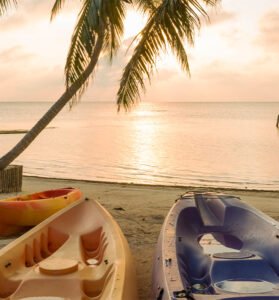Introduction
Newport Harbor is a cornerstone of Southern California’s coastal culture, celebrated for its stunning views, vibrant boating scene, and deep historical roots. Over the centuries, this harbor has evolved from a natural estuary to a bustling maritime hub, attracting adventurers, settlers, and enthusiasts alike. Today, it stands as one of the largest recreational harbors in the United States.
This article delves into the rich history of boating in Newport Harbor, exploring its transformation from a natural waterway into a world-class destination for boating enthusiasts. From indigenous practices to modern infrastructure, Newport Harbor’s story is one of growth, culture, and connection to the sea.
Early Beginnings: The Natural Formation of Newport Harbor
Newport Harbor’s history begins with its natural formation over thousands of years. Originally a series of wetlands and estuaries, the harbor was shaped by tidal movements, sediment deposits, and the ebb and flow of the Santa Ana River. These natural processes created a unique marine environment teeming with biodiversity.
The area’s natural harbor made it an attractive location for early inhabitants. Its sheltered waters provided protection from coastal winds, making it an ideal spot for fishing, transportation, and settlement. The estuary’s abundant marine life, including fish, shellfish, and seabirds, further added to its appeal.
While the harbor’s geography remained relatively untouched for centuries, its potential for development was clear. Early settlers recognized its strategic and economic importance, setting the stage for its future transformation into a maritime hub.
Indigenous Communities and Their Maritime Practices
Long before European settlers arrived, the Newport Harbor area was home to indigenous communities, primarily the Tongva people. These early inhabitants had a deep connection to the land and water, relying on the harbor’s resources for sustenance and trade.
The Tongva used simple, yet effective, boats made from tule reeds, which they crafted into canoes called “ti’ats.” These vessels allowed them to fish, navigate the estuaries, and trade with neighboring tribes along the Southern California coast. Their maritime practices were a testament to their ingenuity and harmony with nature.
Today, the legacy of the Tongva people is commemorated in various cultural and educational initiatives, reminding visitors of the harbor’s earliest navigators and their sustainable way of life.
The Arrival of European Settlers and the Harbor’s Evolution
The arrival of European settlers in the 19th century marked a turning point in Newport Harbor’s history. Initially used as a trading post and fishing hub, the harbor quickly gained attention for its strategic location. By the mid-1800s, settlers had begun modifying the natural landscape to accommodate larger vessels and expand its commercial potential.
The discovery of gold in California and the subsequent population boom further fueled interest in Newport Harbor. Steamships and cargo vessels began to frequent its waters, transporting goods and people to and from the region. Settlers also introduced new fishing techniques and infrastructure, paving the way for commercial expansion.
Despite these changes, the harbor retained much of its natural beauty, attracting visitors who were drawn to its scenic charm and tranquil waters.
The Rise of Commercial Boating and Trade
By the late 19th century, Newport Harbor had become a thriving center for commercial boating. Fishing, in particular, flourished as an industry, with fleets of boats venturing out daily to harvest the region’s rich marine resources. The harbor also became a key stop for cargo ships transporting agricultural products, such as citrus and avocados, to nearby markets.
The establishment of the Pacific Electric Railway in the early 1900s further boosted the harbor’s commercial significance. Improved transportation links made it easier for goods and passengers to move between Newport Harbor and surrounding areas, solidifying its role as a vital economic hub.
This era of commercial growth laid the foundation for the harbor’s eventual transition into a recreational boating destination, as increasing numbers of people were drawn to its dynamic maritime scene.
Transformation into a Recreational Boating Hub
In the early 20th century, Newport Harbor began to shift from commercial to recreational use. Wealthy entrepreneurs and vacationers recognized the harbor’s potential as a leisure destination, leading to the development of waterfront properties, marinas, and luxury amenities.
The construction of jetties in the 1930s further enhanced the harbor’s appeal, improving navigation and making it safer for small recreational vessels. Boating clubs and rental services began to emerge, catering to locals and tourists eager to explore the harbor’s scenic beauty.
This transformation marked the beginning of Newport Harbor’s rise as a premier destination for leisure boating, attracting enthusiasts from around the world.
The Development of Yacht Clubs and Sailing Culture
Yacht clubs played a pivotal role in shaping Newport Harbor’s recreational boating culture. The Newport Harbor Yacht Club, established in 1916, became a hub for sailing enthusiasts, hosting regattas, races, and social events that showcased the harbor’s vibrant community spirit.
Over time, other clubs and organizations followed, promoting sailing, rowing, and competitive water sports. These clubs fostered a sense of camaraderie among boaters and established Newport Harbor as a prestigious location for maritime events.
The emphasis on sailing and yachting also attracted notable figures and celebrities, further elevating the harbor’s reputation as a playground for the elite.
Modern Boating Infrastructure in Newport Harbor
Today, Newport Harbor boasts state-of-the-art infrastructure that caters to a wide range of boating activities. Marinas, docks, and launch ramps provide easy access for boaters, while rental services offer options for those without their own vessels.
The harbor is also home to a thriving eco-tourism scene, with electric Duffy boats and other environmentally friendly options gaining popularity. These innovations ensure that Newport Harbor remains accessible and enjoyable for all while preserving its natural beauty.
Modern navigation systems, harbor patrols, and safety measures further enhance the boating experience, making Newport Harbor a model for sustainable and inclusive maritime development.
Iconic Boating Events and Traditions
Newport Harbor is renowned for its iconic boating events, with the Newport Beach Christmas Boat Parade being one of the most celebrated traditions. This annual event attracts thousands of visitors who come to witness the dazzling display of illuminated boats and holiday cheer.
Other events, such as the Newport to Ensenada International Yacht Race, highlight the harbor’s competitive spirit and its importance within the global boating community. These traditions showcase the harbor’s rich history while bringing the community together in celebration.
Whether it’s a festive parade or a thrilling race, these events underscore Newport Harbor’s enduring appeal as a center for maritime culture and entertainment.
Conclusion
The history of boating in Newport Harbor is a fascinating journey of transformation and innovation. From its origins as a natural estuary to its current status as a premier recreational destination, the harbor has played a vital role in shaping the region’s identity and culture.
Through its blend of natural beauty, rich traditions, and modern amenities, Newport Harbor continues to captivate and inspire. Whether you’re a seasoned sailor or a first-time visitor, the harbor offers an experience that connects you to its storied past and vibrant present.
Excited for an adventure with us or have a question? Call us at: (949) 675-8433 Book Your Ride with us: Click here to Book



